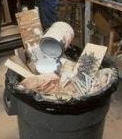- Cleaning:
Lead based paint remediation or abatement generates lead based, contaminated particles, flakes and debris. If you do not clean-up the job-site properly you will have created a greater hazard than the lead based paint hazard you were originally dealing with.
- Daily Clean-Up
- Final Clean-Up
Once you have completed your day's worth of lead based paint removal you should apply a misting application of water over any and all debris, this will help to keep the particulate from floating into the air as it is picked up.

Figure 14 - 4-mil garbage bags
That debris should then be packaged in a 4-mil garbage bag (Figure 14), and the bag should be sealed off with a garbage tie. That garbage bag should then be placed in a second 4-mil garbage bag and that bag should be sealed with a garbage tie. Don't forget to empty the vacuum cleaner if it has been used.
Once all of the debris has been placed in the garbage bags, the floors, walls, ceilings, trims and any other area that may have been in contact with or exposed to lead based paint particulate should be damp mopped and/or damp dusted. Don't forget to wipe down ladders and tools.
This is a critical part of your lead based paint abatement or remediation project. Using your HEPA vacuum (Figure 10) all surfaces that have been potentially subjected to the lead based paint particulate generated, should be thoroughly and completely vacuumed. As well, all wood surfaces should be wet mopped using a heavy duty cleaning agent, including window and door surfaces, window and door trim, moldings and floors. After the wet mopping is complete and the surfaces have dried a second vacuuming with the HEPA filter vacuum is recommended.
If you removed items such as children's toys, dog toys or beds, rugs, carpets, drapes, bedding and upholstered furniture from the room prior to the remediation, and you had a flaking and or powdering problem, it is likely that these articles are contaminated with lead based paint particulate. These items should be replaced or if that is not economically reasonable they should be professionally cleaned, prior to replacing them in the remediated area.
- Disposal Of Debris
- Contracting The Remediation Project:
Again it is very important that you check for any regulations and legislation in your area that may determine the method or methods available for the disposal of lead based paint debris and/or hazardous waste. In many areas if the debris is bagged as described in section 5 it can be disposed of through the homeowners regular residential garbage pick-up. However, in other areas hazardous waste must be taken to specific collection areas for special processing.
The water that was used to mop surfaces is now contaminated with lead based paint particulate and should not be disposed of down toilets, sink drains or residential sewage systems. Pour the waste water through a filtering cloth before disposing of it. Then dispose of the filtering cloth in the same manner as the rest of the debris.
Any cleaning tools, such as mops, brooms, dust pans and rags, used during the abatement project should be discarded. The HEPA filter in the vacuum cleaner should also be removed and disposed of with the rest of the contaminated waste. Don't forget to thoroughly wash out the vacuum cleaner and its accessories.
If you feel that removing the lead based paint from your home is to onerous a home handyman task, there are, in most areas, specialty contractors that are licensed to provide lead based paint abatement services.
Always get more than one estimate and always check out the contractors references.
Additional information on selecting and hiring contractors.
